In December, we chatted with Luke Lickfold, the AV Infrastructure Manager at UQ. We discussed the biggest changes in the AV world over the past five years, shared tips for new businesses starting their AV journey, and discussed the surprise impact of USB-C.
The Most Significant Changes in the Last 5 Years
Chelsea: AV has changed extremely rapidly in the last decade; what would you say are the biggest changes you’ve seen in the last 5 years?
Luke: The initial big change was going to Innomate specifically but really to a cloud control platform. That’s something we had committed to doing before we found innomesh as a solution. We were doing that whether it was with Innomate or something else. 5 years later, I’m glad we made that choice; it’s worked very well. We would be in the cloud control paradigm regardless; it’s where we absolutely had to be, and I would never go back. And then, of course, we had the pandemic in the middle, which is the other huge change that’s going on – in the teaching space, the amount of hybrid learning that goes on but same with the meeting space, the amount of online and hybrid meetings has just absolutely shot up as a result. During the pandemic, it was less hybrid, and everything was 100% online. Now, post-pandemic, it’s like half of that has remained, so we’re very much hybrid, and that’s where we are at.
Neil: So, did the pandemic force more velocity and change?
Luke: I’d say so! Yeah, if you went back 10 years ago, a meeting room was just about local presentations; it was just about AV for talking to people in the room and presenting to people, so it was much more of a strip-back thing. I’d say about 7 years ago; we started fitting out meeting rooms for hybrid and online as a standard. That was pre-pandemic, but by the time we hit the pandemic, a good number of our meeting rooms were ready for that, but it was never rooms only. Obviously, we rolled out some stuff to make it work everywhere. The teaching spaces were essentially not kitted out for that at all. We had next to zero hybrid or online capability for the teaching spaces, and that was appropriate pre-pandemic; there wasn’t much hybrid learning going on. I shouldn’t say none; it’s not really near zero; it’s more like 5 to 10%. But even what was happening was usually more about connecting campus to campus, so it was more about having this teaching space joining a VC call with this teaching space at St Lucia, and you are having a remote presenter from site to the other or cohort of students joining from one site to another. It was really about just that piece as opposed to having half of the people joining from home because before the pandemic, those half of the people being students, they wouldn’t have known how to join from home, and nobody really had Zoom or knew what it was, etc. The pandemic just rammed all of that through, and it really wasn’t like it changed something that was changing slowly and made it change fast; that was the case for the meeting rooms. For the teaching spaces, it added a whole new paradigm that absolutely had to happen instantly, where there was mostly nothing.

Large Collaborative Teaching Space at the University of Queensland
From infrastructure encroachment of AV to “domination”
Neil: This has gone from Infrastructure encroachment of AV to AV is central and its domination so what are those conversations like now with your IT team, the wider infrastructure team, the data team and the infosec. Are they still the same conversations?
Luke: The infrastructure network team, I mean, we’ve gone from being, I’d say 10 – 11 years ago when I started, not the stuff, the new stuff we were putting in then, but the old stuff that we had when I started at UQ was like you had a master controller and a touch panel were the only parts of the AV system that were on the network. So you had a gigantic teaching space, and that’s two IPs, so it’s two items on the network of a gigantic lecture theatre with all this equipment that all talks via serial from an AV perspective and is online basically just for the master’s touch panel to communicate to it. Now, every single item in that space is its own, a networked unit, and they all communicate via IP. Beyond that, there are heaps of items that weren’t there at all before. So, in a big collaborative teaching space, we might have 35 units with an IP address; we are one of the biggest customers of our infrastructure team and hardware. Also, because the user space has gone the other way, call it cutting the blue cable. The need to have your PC at your desk hardwired into the network has gone away, so while users have gone all WIFI, we have increased the number of network ports we consume. We’ve essentially just taken over from the end users as the primary consumers of the hardware network. The other change is that we are actually piping the audio and the video through the network these days. That’s a massive change, and that’s something we work really hard on with them. AV over IP is something we are still absolutely using in production in teaching spaces, but we kind of trade it with caution, and we have to work slowly and carefully with our team as we can’t just shove it into a building with an older network with limited bandwidth on the up links because that will just crash everything.
Consider the fleet
Chelsea: When you think of a new organisation, a brand new organisation, they are only just starting up – what would be the first piece of advice you would give that company for their AV?
Luke: Consider the fleet. Standardisation and fleet and support. By considering the fleet, I mean consider support, manageability and scalability. Scalability is so important, and it means standardisation and repeatability.

From a support and fleet management point of view, we manage over 1500 AV systems; they’re all online and being monitored. We provide really fast response support for the whole lot with a very small team. I won’t go into specific numbers, but all of that is only possible due to the cohesion of that environment.
Recent Surprises in AV Technology
Neil: When was the last time something surprised you in what you do or just in AV in general? Something you didn’t see coming?
Luke: USBC, I didn’t see coming, let’s go with that. I’m still getting my head around. I feel like USBC just came up out of left field, really. It’s not just about one cable to push in a whole bunch of stuff; it really changes the way things work. For instance, in a meeting room, it needs to do all of the hybrid pieces. We used to have a screen and a sound bar with a camera in it, microphone speakers, and all of that plugged into a micro PC behind the screen. This is all fairly standard; the user can come and log in with a keyboard and mouse and have a meeting with that PC. They’ve got to log in with that PC, open up their preferred conferencing software, and mess around. We don’t have Teams rooms or Zoom rooms at UQ because we are essentially platform agnostic. Even if it’s a Teams or Zoom room, it’s a much better experience when you can dial a system into a meeting instead of having to crack it open. My point is that in those meeting rooms, we would then have an HDMI lead for a laptop experience, but the laptop experience was kind of just local display only, or you can have it fed through the PC somehow through the Zoom or teams rooms, but even then you’re still dialling the meeting room system into a call and then sharing your laptop through the system. Now, with USBC and the USBC hub switching box, you can just plug in your laptop and have it steal all the peripherals from the room, like video, audio, and everything. You can steal it all with one cable and have it charging your laptop at the same time and have your meeting really quickly running your laptop itself, but using the room’s peripherals, that’s a whole new paradigm. We’ve started deploying that as our new meeting room designs, so we don’t deploy any meeting rooms without the facility to do all of that with USBC now and that’s been a huge difference.
A huge thanks to Luke for joining us and sharing his expertise on AV in the education sector. Keep an eye out for more fascinating talks about the future of work and tech. Make sure to subscribe to our podcast on Spotify and YouTube and turn on notifications so you never miss an episode!
You can also watch the full episode here.


